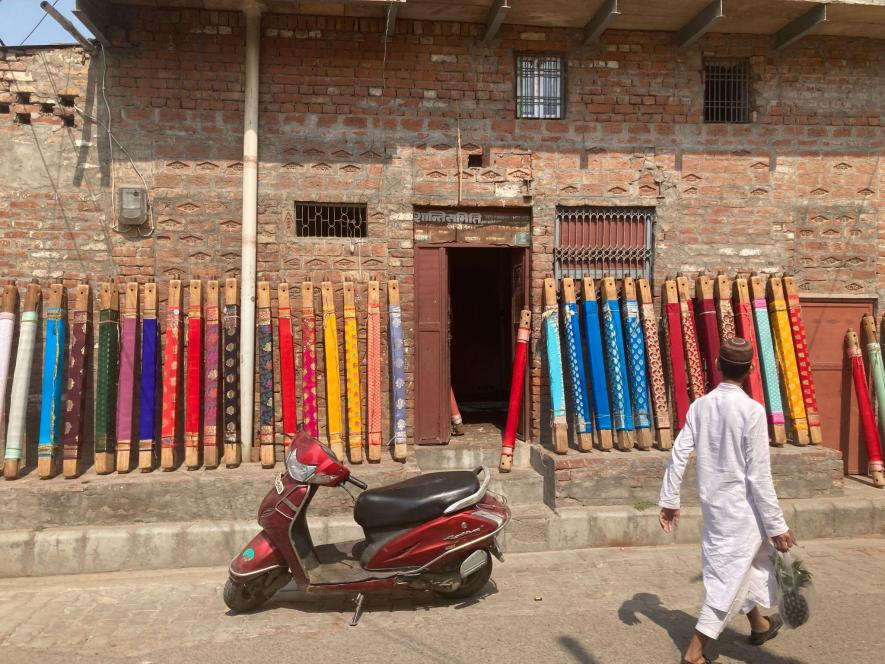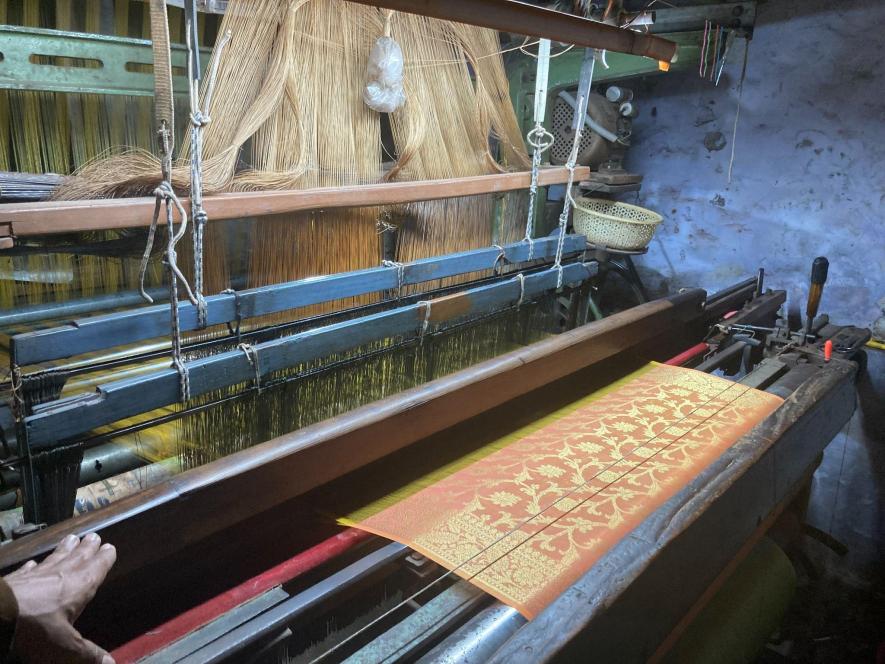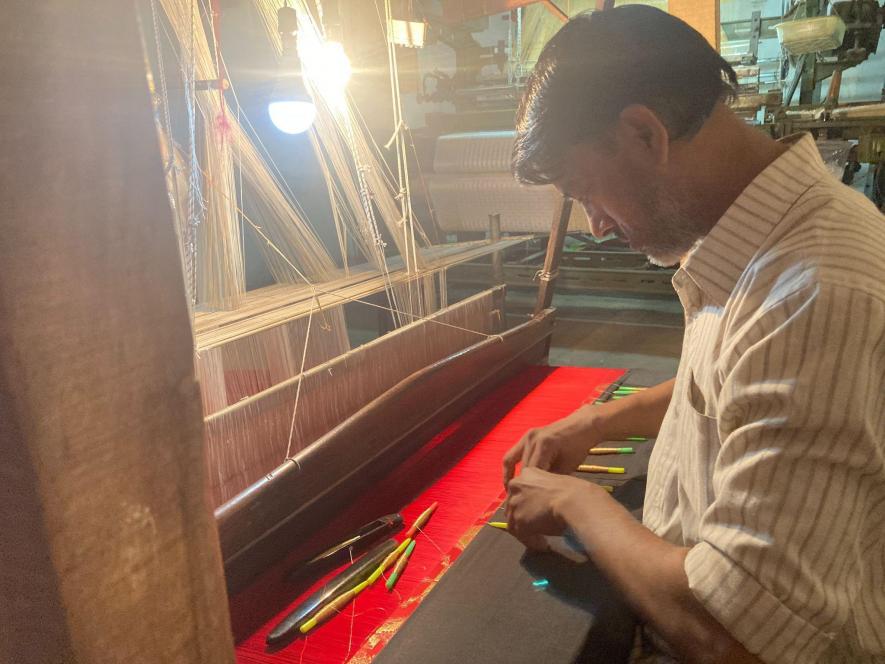Banaras' Bunkar Community Stuck in the Rut of Polarising Hindu-Muslim Politics, Demands a Revival of Their Business

A bunkar home in Nati Imli, Banaras, having many Banarasi sarees rolled up outside
In Lallapura, Banaras, the afternoons are full of silenced streets with occasional noise of powerlooms as one walks around the area's narrow lanes, indicating that men from the bunkar community are at work at the looms.
The bunkar community is a weaver community famous for producing Banarasi silk sarees and other attractive garments which have significance in festivals and various important occasions. It also has a lot of export value to other countries such as Bangladesh and Pakistan.
The noise from powerlooms may indicate business as usual. Moinuddin, a bunkar with two powerloom machines, suggests otherwise. Noticing him sitting at a small shop selling small refreshments such as packets of chips, he was asked if he owned the powerloom running nearby.
"Yes, I have two powerlooms, and one of them is being used by my son to complete an order of sarees. I am a bunkar, but as you see, the situation is so bad that I also run this small shop to make ends meet," Moinuddin said, adding, "I have no profit margin in doing bunkari these days. The machines are only running so that they don't get junked and rusted while sitting idle."
He explains his plight in detail. Articulating every aspect of saree-making, the ever-increasing price of supplies such as taana (spools of thread), electricity bills to run the powerlooms, the wages earned by bunkar labourers, etc., he concludes that he earns an abysmal profit of Rs 70-100/saree.
"I am a small-time bunkar running only two looms- one of them is rented. I used to make sarees and other articles such as scarfs for sherwanis in bulk in these two powerlooms and would profit every lagan (festive occasion). That was the story some eight years ago. What has happened in the past few years, especially since the present state government came into power, is that the grihasthas (elite, capitalist bunkars owning a large number of powerlooms) has benefitted much from the policies of the government, and the small bunkars have no role to play anymore," laments Moinuddin. He has three children, out of which the eldest one has graduated with a bachelor's degree, and the rest are sitting idle, only passing VII standard.
"I don't have the money to send my children to school either, only the eldest one has a degree, and he is also engaged in the powerloom work," Moinuddin said.

Moinuddin’s powerloom at work
The market of Banarasi sarees has been going downhill since the present government’s rise, further aggravated by the COVID-19 crisis that brought the world to a halt, and the business of bunkari was not spared. Many bunkars say that the market of sarees picked up a little bit post-lockdown, but the government has not been able to promote the export of sarees which may help improve demand. Overall, it is found that the markets of Banarasi saree have still not recovered from the brunt of the lockdown. The prices of supplies such as taana, zari and silk are at an all-time high.
Parvez, a bunkar labour from the Nati Imli area of the city, running a power loom, says that the grihasthas are business people who have started selling the products of bunkars throughout the country and outside as well.
“We are people who do labour and work on the order of the seths (grihasthas) using the supplies provided by them. They handle the rest of the business and thus the market; we remain labourers as we work on their behalf,” Parvez notes.
Many bunkars like Parvez look for help from the state government to aid their labour.
“The government should create more schemes for our community. In the previous Samajwadi Party (SP) government, we had a subsidy on electricity that helped save us some profit. This has been removed in the Bharatiya Janata Party (BJP) government. Other schemes only benefit the grihasthas as it aids their business,” Parvez said, further stating that there has been no improvement in the labour wages/saree.
One saree earns him around 200 rupees (varying according to the amount of work and design put on the saree), and this has not seen any improvement whatsoever, even though inflation has been soaring high.
Gulzar, another bunkar labourer in the area, says, “Our work is intermittent and always shuts down for weeks. Our product doesn’t sell, and inflation greatly affects us. Supplies get costly, and the labourer is distressed overall. The grihasthas are also affected by a slow market, and they stop taking our products from us, and our looms shut down for days and weeks.”
He further notes that when work resumes, they work for almost 18 hours a day to make ends meet, hoping that they could earn a little extra in their precarious line of work.
In the areas of Banaras where bunkars live, such as Nati Imli, Bajardiha, etc., the noisy powerlooms may overshadow the declining art of handloom bunkars. The Banarasi silk saree, made by a handloom, has a starting market price of Rs 25,000, increasing according to the careful and dense design work that a handloom weaver does.
“It takes at least 25 days to make one saree for me, I have learnt the work from my ancestors, and we have this one handloom machine. It is not an easy thing to do and takes a lot of effort and years of practice to learn it,” says Aftab, one of the only handloom weavers in Nati Imli. He has been doing the handloom work for the past 40 years and is now reaching 60.
“I get some Rs 5,000-10,000 in a month. The rest of the profit is earned by the bigger businessmen to who I sell my sarees,” Aftab said.
After surviving the COVID-19 lockdowns, he is still in debt and says he is taking away some of his monthly earnings to repay the debts.
“It will take another year for me to clear my debt; there was no work in the lockdowns. Markets restarted after the lockdown, but it didn't matter. The seths will order sarees from me, and I only get wages for my labour; the market demand doesn’t affect me. They will keep my sarees and will sell it whenever there are occasions to do so,” Aftab said.

Aftab working at his handloom
The demand for Banarasi silk saree made at handlooms is different from those made on powerlooms. The powerloom sarees are cheaper and hence have a higher demand, but since the marketplace has generally seen a decline, many bunkars are said to have left their traditional jobs.
“Many have started running auto-rickshaws; others did labour work. Some left the city to other cities like Bangalore because they get better wages than in Banaras,” said Moinuddin, who used to have other bunkar labourers running his looms, but now himself runs them with the help of his eldest son.
Though the bunkar community is predominantly Muslim, to ignore the larger trade of Banarasi sarees and cloth items made at the looms that have a good role of people from the Hindu community is to be myopic of the whole tradition of the weavers of Banaras.
Rajesh, a Hindu bunkar in Lallapura, runs a single powerloom; his two sons help him out. Ali, his friend who supplies him with taana for his loom, sits with him at his small rented place where the powerloom is working, and they watch cricket together while eating paan.
“You can see it right; the bunkar karobar is run by both Hindus and Muslims,” Ali stated to me, adding, “Rajesh bhaiya has been a dear friend of mine for many decades; we have many interactions apart from our business as well.”
Rajesh’s son, Bhairav, who was working the machine as we all discussed the plight of the bunkar community, staunchly asserted the cordial connection between Hindus and Muslims.
“We are always there for each other. Any festive occasion of ours, be it a puja or a wedding, we invite our friends from the Muslim community, and we wholeheartedly participate in their festivals as well,” Bhairav said.
Both Rajesh and Ali are there for each other in the best and worst of their lives.
“We are going through this depressing period, and our karobaar is in decline together. All we can do is joke about it with each other and share our distress. We have no hope from the present or the upcoming government, be it any party,” Rajesh said. He says that he has reduced investments in his family to a half.
“Gone are those days when I used to give my children many gifts like clothes during Holi and Diwali; now, I simply cannot,” Rajesh said. While he eats a paan, he tears it into a half and folds and keeps the remaining half on his side. Bhairav sarcastically comments, “See this, my father is eating even his paan in half to save up!”
The Hindu-Muslim polarisation that has been the identity of the present state government is a direct affront to such an ecosystem that sustains the bunkar community. This ecosystem is an example of the Banaras’ Ganga-Jamuni Tehzeeb.
Gulzar says, “The BJP government is all about a politics of discrimination. We don’t like it; we (Muslims) make sarees, and Hindus sell them. Both Hindus and Muslims are part of this business, and we shouldn’t be divided, and all should live harmoniously.”
Ali says that relations between Hindus and Muslims are tightly intertwined to help and benefit each other. Only a few people in the city are destroying the harmonious tehzeeb of the city.
“This tehzeeb will never go away; those who want to decimate it will get decimated themselves; we want to oust such a political party,” Bhairav said, supporting Ali.
Recently, CM Yogi Adityanath remarked that the UP assembly elections would be about ‘80% vs 20%’, antagonising the 20% Muslim population of the state. Angered by such a statement, Rajesh comments, “My family and I have been BJP supporters for long, but if our CM comes and tells us that a ‘20%’ people, those who are very dear to me do not mean anything to the government, I do not feel good about it and shall not tolerate it.”
Ali further laments, “This is hurtful. We are made to feel we are already less in number, so either we join your treacherous politics or perish. What else can we do!”
In the end, all bunkars demand a revival of their karobaar. “We don’t need anything else, no more divisions or discrimination. Nor are we happy with the government making houses and providing us free rations,” Rajesh said, pointing to the benefactor schemes of the Modi-Yogi government of Pradhan Mantri Awas Yojna and free monthly ration distributions, “Give us employment and our give us our businesses, so we can make our own homes and make our food!”
The writer is a freelance journalist.
Get the latest reports & analysis with people's perspective on Protests, movements & deep analytical videos, discussions of the current affairs in your Telegram app. Subscribe to NewsClick's Telegram channel & get Real-Time updates on stories, as they get published on our website.














